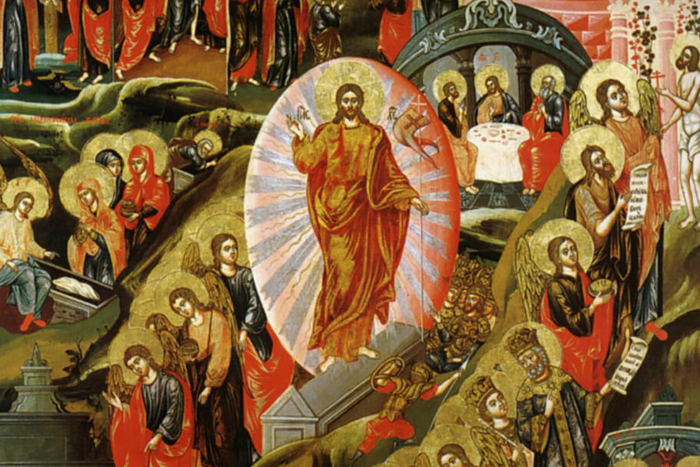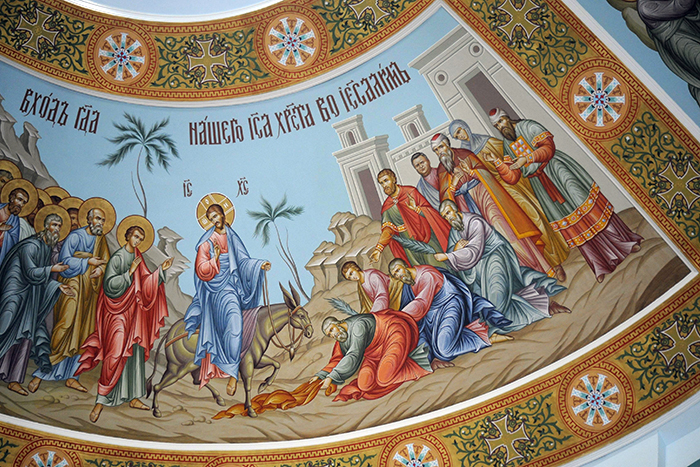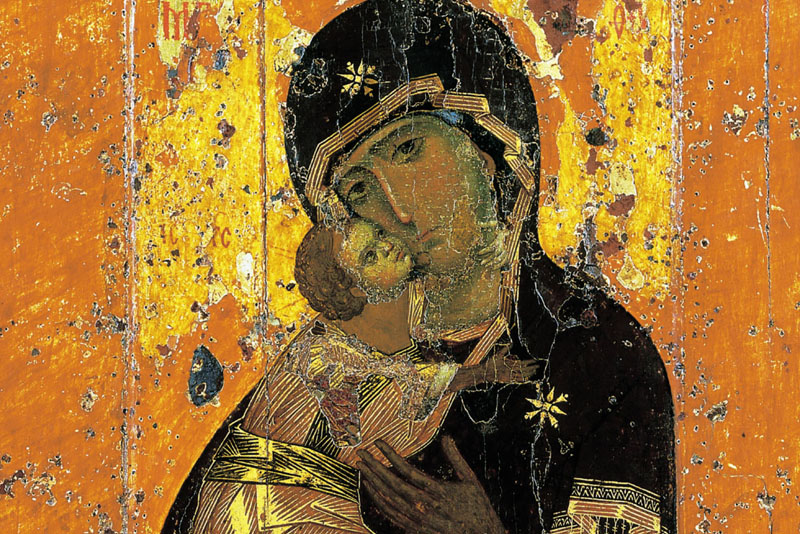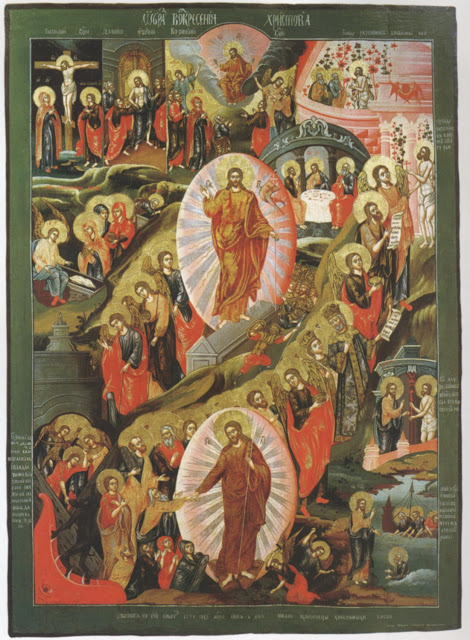
In the tomb with the body, in hell with the soul as God, in paradise with the thief and on the throne with the Father and the Spirit, You fill all things, O boundless Christ.
The prayer above, said by the priest during the Divine Liturgy, attempts to describe in words the mystery of Jesus Christ’s death, burial and resurrection. Simply put, Christ, being truly God, remained “omnipresent” – everywhere – even whilst seemingly constrained by a human body.
The Resurrection Icon above, one of many similar that appear around the Vologda region of Russia during the 17th century, proclaims much the same thing in paint.
In the Tomb with the Body

At the centre of the scene is Christ “in the tomb”, though because it is a Resurrection icon it is instead showing Jesus’ physical rising from the tomb. Clothed in glorious golden robes, Jesus emerges from the stone coffin, with the discarded grave clothes still visible. To Christ’s left the soldiers appointed to guard His tomb are witnesses to the empty tomb, whilst to His right are the angels which rolled away the stone and would later declare the good news to Mary Magdalene. Below Jesus’ feet is a globe, or sometimes a part of a globe, representing Christ’s victory over the world through His physical Resurrection.
When the composition of this icon becomes set after the 17th century, Christ is almost always also shown holding a banner (called in Russian a Khorugv) bearing a red cross as He rises from the tomb. This image of the Resurrection by itself is probably more familiar to western Christians (e.g. Dieric Bout’s Resurrection, c. 1455)
In hell with the soul as God
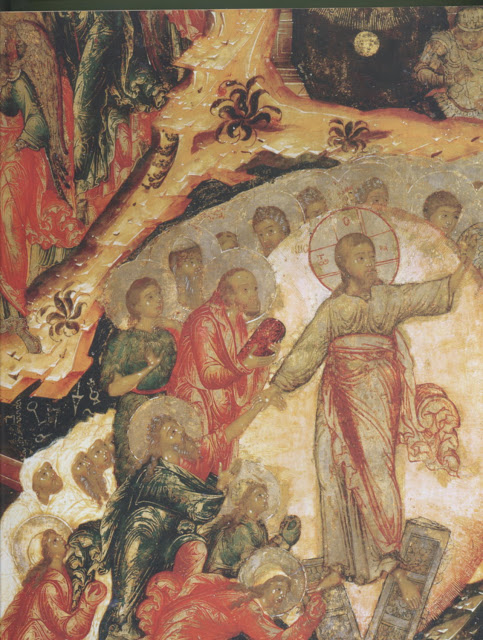
Below the image of Christ rising physically from the tomb is the image of the spiritual resurrection: the harrowing of hell, or hades. It is the ancient Christian belief that when lying bodily in the tomb, Christ’s soul descended into hell just as all those who reposed before Him had done. However, being Divine, Christ’s descent into Hades was not as a prisoner, but a liberator, destroying the gates and chains of the underworld, and opening up the way to paradise.
This image of the Resurrection is emphasized in Orthodoxy, so much so that most icons of the Resurrection depict this scene by itself. The symbolism of the Harrowing of Hades is described fully in the post “The Resurrection – Icon of Victory“.
In these later icons, the harrowing of hades is shown much how it is in the earlier icons of the resurrection: Christ pulling Adam from the tomb; the gates of Hades trampled beneath Christ’s feet; a mandorla surrounding Christ’s body. The only difference in the later icons is that hell, sometimes shown as a great monster, is placed in the bottom left corner spewing out the freed captives. Christ points with His free hand towards the top right of the icon, where paradise is shown as a walled garden. The Old Testament righteous – Moses, Abel, the Kings David and Solomon etc – are escorted by angels from the the tomb to paradise, creating a striking diagonal sweep of golden halos that dominate the icon.
In paradise with the Thief
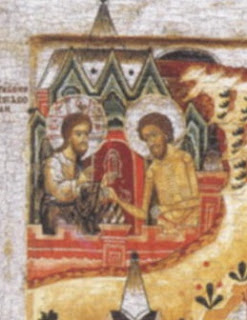
On Golgotha, Christ was flanked by two thieves, being crucified with Him. One, on Christ’s left, hurled abuse and blasphemies at Jesus, whilst the other rebuked the unrepentant thief and cried out to His Saviour: “Lord, remember me when You come into your Kingdom!” To the repentant thief, known in Christian tradition as Dismas, Jesus Christ uttered the immortal words: “Amen, I to you: Today you shall be with Me in paradise.”(Luke 23:32-43)
The Church has understood the use of the word “today” to be literal, and so in death Jesus Christ’s divinity is revealed: being present on earth (in the tomb), “under” the earth (harrowing Hades), and “up above” in paradise, all at the same time. Therefore, Christ is shown at the gates of paradise greeting the repentant thief (usually to the right of the icon). Often, the thief will be shown again in paradise (with flaming-Cherubim still guarding the entrance), entering ahead of all the other righteous being freed from Hades (compare the icon of “Abraham’s Bosom” here)
On the throne with the Father and the Spirit

It is a belief stated many times in Orthodox prayers that the Father, the Son (Jesus Christ), and the Holy Spirit are together a Holy Trinity “one in essence and undivided” (from the Divine Liturgy).
This tri-unity is expressed in the prayer quoted at the beginning of this post: even as He lay bodily in the tomb, His soul descending into Hades, and greeting the repentant thief in paradise, Jesus Christ was, and is always, reigning eternally with His Father and the Holy Spirit.
This image of Christ reigning in Heaven as the second person of the Holy Trinity is sometimes depicted at the top of the icon. Often, as in the example shown here, the image of the Holy Trinity is combined with a depiction of the Ascension of Christ (Acts 1:9-11). Jesus Christ is shown as part of the so-called “New Testament Trinity”, which is discussed in the post Holy Trinity Icon of the Written Stone Monastery
Other scenes of the Incarnation and the Resurrection

As well as showing the bodily Resurrection, the spiritual Resurrection, and opening of paradise by Christ, icons of this sort are also furnished with various Gospel scenes.
Most of these scenes are post-Resurrection, and include: the Discovery of the Empty Tomb by the Myrrh-Bearing Women (Matt 28:1-10; Luke 24:1-10) St Peter inspecting the empty tomb, sometimes with the Apostle John present ( Luke 24:10-12; John 20:1-9); Christ’s appearance and supper with the disciples at Emmaus (Luke 24:13-32); the appearance of Jesus to (Doubting) Thomas (Jn. 20:24–29); the appearance of Jesus to the Apostles on the Sea of Tiberias (John 21:1-9 — usually depicted in the bottom left of the icon); and the Ascension of Christ, mentioned earlier.
In addition, there is sometimes an image of the Crucifixion near the top of the icon, completing the Passion and Paschal narrative. Together, the scenes in icons like this bring together all aspects of Christ’s Resurrection, and in it shows us His divinity:
In the tomb with the body, in hell with the soul as God, in paradise with the thief and on the throne with the Father and the Spirit, You fill all things, O boundless Christ.

